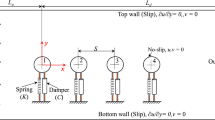Abstract
Power harvesting from vortex-induced vibration (VIV) is a fairly new regime that needs to be explored. A practical VIV-based hydroelectric farm will employ a number of devices undergoing VIV. The present work aims to quantify the energy extraction capability of two rigidly-coupled circular cylinders of equal diameter (D) in tandem arrangement. The energy extraction process is modeled using a damper attached to the vibrating cylinders. The cases with different dam** ratios (ζ) are numerically simulated by OpenFOAM, an Open-source software computational fluid dynamics solver. The cylinders are rigidly -coupled and oscillate rigidly in the cross-flow direction. All the cases were simulated at a constant mass ratio, defined as the ratio between net oscillating mass to the mass of displaced fluid, 2 and Reynolds number 150. The gap ratio (L/D), defined as the normalized center-to-center distance between the cylinders in cross-flow direction, is taken as 2. The dam** ratio is varied in the range of ζ = 0.025–0.10, and the reduced velocity (U∗) is varied from 3 to 8.5. At the smallest dam**, the cylinders vibrate with significant amplitude in the reduced velocity range of 4–6, the synchronization region. A maximum vibration amplitude (y/D) value of 0.51 is observed close to reduced velocity 5 at the smallest dam**. This value is close to that of an isolated circular cylinder. The vibration amplitude decreases with increasing dam** as some of its kinetic energy is dissipated, which is assumed to equal the extracted power in the present case. The width of the synchronization region also decreases with increasing dam**. The mean extracted power is maximized at certainly reduced velocities in the synchronization region at each dam** value. The extracted power is proportional to both dam** and vibration amplitude. Since the vibration amplitude reduces with dam**, an optimal dam** value at which a peak value of the maximum extracted power is obtained. For the present case, the non-dimensional peak extracted power is close to 0.069 at ζ = 0.04 and U∗ ≈ 4.5.
Access this chapter
Tax calculation will be finalised at checkout
Purchases are for personal use only
Preview
Unable to display preview. Download preview PDF.
Similar content being viewed by others

References
M. M. Bernitsas, K. Raghavan, Y. Ben-Simon, and E. Garcia, “Vivace (vortex induced vibration aquatic clean energy): A new concept in generation of clean and renewable energy from fluid flow,” 2008.
A. K. Soti, M. C. Thompson, J. Sheridan, and R. Bhardwaj, “Harnessing electrical power from vortex-induced vibration of a circular cylinder,” Journal of Fluids and Structures, vol. 70, pp. 360–373, 2017.
J. Lee and M. Bernitsas, “High-dam**, high-reynolds viv tests for energy harnessing using the vivace converter,” Ocean engineering, vol. 38, no. 16, pp. 1697–1712, 2011.
H. Sun, E. S. Kim, G. Nowakowski, E. Mauer, and M. M. Bernitsas, “Effect of mass-ratio, dam**, and stiffness on optimal hydrokinetic energy conversion of a single, rough cylinder in flow induced motions,” Renewable Energy, vol. 99, pp. 936–959, 2016.
A. Barrero-Gil, S. Pindado, and S. Avila, “Extracting energy from vortex-induced vibrations: a parametric study,” Applied mathematical modelling, vol. 36, no. 7, pp. 3153–3160, 2012
G. d. S. Assi, J. Meneghini, J. Aranha, P. Bearman, and E. Casaprima, “Experimental investigation of flow-induced vibration interference between two circular cylinders,” Journal of fluids and structures, vol. 22, no. 6-7, pp. 819–827, 2006.
D. Sumner, “Two circular cylinders in cross-flow: a review,” Journal of fluids and structures, vol. 26, no. 6, pp. 849–899, 2010.
M. Zdravkovich, “Review of interference-induced oscillations in flow past two parallel circular cylinders in various arrangements,” Journal of Wind Engineering and Industrial Aerodynamics, vol. 28, no. 1-3, pp. 183–199, 1988.
L. Ding, M. M. Bernitsas, and E. S. Kim, “2-d urans vs. experiments of flow induced motions of two circular cylinders in tandem with passive turbulence control for 30,000 < Re < 105,000,” Ocean Engineering, vol. 72, pp. 429–440, 2013.
L. Ding, L. Zhang, E. S. Kim, and M. M. Bernitsas, “Urans vs. experiments of flow induced motions of multiple circular cylinders with passive turbulence control,” Journal of Fluids and Structures, vol. 54, pp. 612–628, 2015.
M. Zhao, “Flow induced vibration of two rigidly coupled circular cylinders in tandem and side-by-side arrangements at a low reynolds number of 150,” Physics of Fluids, vol. 25, no. 12, p. 123601, 2013.
I. Borazjani and F. Sotiropoulos, “Vortex-induced vibrations of two cylinders in tandem arrangement in the proximity–wake interference region,” Journal of fluid mechanics, vol. 621, pp. 321–364, 2009.
E. S. Kim and M. M. Bernitsas, “Performance prediction of horizontal hydrokinetic energy converter using multiple-cylinder synergy in flow induced motion,” Applied energy, vol. 170, pp. 92–100, 2016.
H. Sun, C. Ma, E. S. Kim, G. Nowakowski, E. Mauer, and M. M. Bernitsas, “Hydrokinetic energy conversion by two rough tandemcylinders in flow induced motions: Effect of spacing and stiffness,” Renewable Energy, vol. 107, pp. 61–80, 2017.
J. Meneghini, F. Saltara, C. Siqueira, and J. Ferrari Jr, “Numerical simulation of flow interference between two circular cylinders in tandem and side-by-side arrangements,” Journal of fluids and structures, vol. 15, no. 2, pp. 327–350, 2001.
T. Prasanth and S. Mittal, “Vortex-induced vibrations of a circular cylinder at low reynolds numbers,” Journal of Fluid Mechanics, vol. 594, pp. 463–491, 2008.
Author information
Authors and Affiliations
Corresponding author
Editor information
Editors and Affiliations
Rights and permissions
Copyright information
© 2023 The Author(s), under exclusive license to Springer Nature Singapore Pte Ltd.
About this paper
Cite this paper
Pal, A., Soti, A.K. (2023). Power Harvesting from VIV of Rigidly-Coupled Cylinders in Tandem Arrangement. In: Bhattacharyya, S., Chattopadhyay, H. (eds) Fluid Mechanics and Fluid Power (Vol. 1). FMFP 2021. Lecture Notes in Mechanical Engineering. Springer, Singapore. https://doi.org/10.1007/978-981-19-7055-9_53
Download citation
DOI: https://doi.org/10.1007/978-981-19-7055-9_53
Published:
Publisher Name: Springer, Singapore
Print ISBN: 978-981-19-7054-2
Online ISBN: 978-981-19-7055-9
eBook Packages: EngineeringEngineering (R0)



